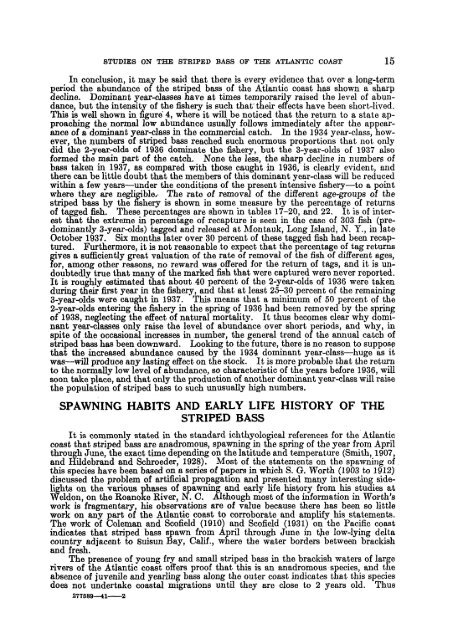Fishery bulletin of the Fish and Wildlife Service - NOAA
Fishery bulletin of the Fish and Wildlife Service - NOAA
Fishery bulletin of the Fish and Wildlife Service - NOAA
You also want an ePaper? Increase the reach of your titles
YUMPU automatically turns print PDFs into web optimized ePapers that Google loves.
STUDIES ON THE STRIPED BASS OF THE ATLANTIC COAST 15<br />
In conclusion, it may be said that <strong>the</strong>re is every evidence that over a long-term<br />
period <strong>the</strong> abundance <strong>of</strong> <strong>the</strong> striped bass <strong>of</strong> <strong>the</strong> Atlantic coast has shown a sharp<br />
decline. Dominant year-classes have at times temporarily raised <strong>the</strong> level <strong>of</strong> abundance,<br />
but <strong>the</strong> intensity <strong>of</strong> <strong>the</strong> fishery is such that" <strong>the</strong>ir effects have been short-lived.<br />
This is well shown in figure 4, where it will be noticed that <strong>the</strong> return to a state approaching<br />
<strong>the</strong> normal low abundance usually follows immediately after <strong>the</strong> appearance<br />
<strong>of</strong> a dominant year-class in <strong>the</strong> commercial catch. In <strong>the</strong> 1934 year-class, however,<br />
<strong>the</strong> numbers <strong>of</strong> striped bass reached such enormous proportions that not only<br />
did <strong>the</strong> 2-year-olds <strong>of</strong> 1936 dominate <strong>the</strong> fishery, but <strong>the</strong> 3-year-olds <strong>of</strong> 1937 also<br />
formed <strong>the</strong> main part <strong>of</strong> <strong>the</strong> catch. None <strong>the</strong> less, <strong>the</strong> sharp decline in numbers <strong>of</strong><br />
bass taken in 1937, as compared with those caught in 1936, is clearly evident, <strong>and</strong><br />
<strong>the</strong>re can be little doubt that <strong>the</strong> members <strong>of</strong> this dominant year-class will be reduced<br />
within a few years—under <strong>the</strong> conditions <strong>of</strong> <strong>the</strong> present intensive fishery—to a point<br />
where <strong>the</strong>y are negligible.- The rate <strong>of</strong> removal <strong>of</strong> <strong>the</strong> different age-groups <strong>of</strong> <strong>the</strong><br />
striped bass by <strong>the</strong> fishery is shown in some measure by <strong>the</strong> percentage <strong>of</strong> returns<br />
<strong>of</strong> tagged fish. These percentages are shown in tables 17-20, <strong>and</strong> 22, It is <strong>of</strong> interest<br />
that <strong>the</strong> extreme in percentage <strong>of</strong> recapture is seen in <strong>the</strong> case <strong>of</strong> 303 fish (predominantly<br />
3-year-olds) tagged <strong>and</strong> released at Montauk, Long Isl<strong>and</strong>, N. Y., in late<br />
October 1937. Six months later over 30 percent <strong>of</strong> <strong>the</strong>se tagged fish had been recaptured.<br />
Fur<strong>the</strong>rmore, it is not reasonable to expect that <strong>the</strong> percentage <strong>of</strong> tag returns<br />
gives a sufficiently great valuation <strong>of</strong> <strong>the</strong> rate <strong>of</strong> removal <strong>of</strong> <strong>the</strong> fish <strong>of</strong> different ages,<br />
for, among o<strong>the</strong>r reasons, no reward was <strong>of</strong>fered for <strong>the</strong> return <strong>of</strong> tags, <strong>and</strong> it is undoubtedly<br />
true that many <strong>of</strong> <strong>the</strong> marked fish that were captured were never reported.<br />
It is roughly estimated that about 40 percent <strong>of</strong> <strong>the</strong> 2-year-olds <strong>of</strong> 1936 were taken<br />
during <strong>the</strong>ir first year in <strong>the</strong> fishery, <strong>and</strong> that at least 25-30 percent <strong>of</strong> <strong>the</strong> remaining<br />
3-year-olds were caught in 1937. This means that a minimum <strong>of</strong> 50 percent <strong>of</strong> <strong>the</strong><br />
2-year-olds entering <strong>the</strong> fishery in <strong>the</strong> spring <strong>of</strong> 1936 had been removed by <strong>the</strong> spring<br />
<strong>of</strong> 1938, neglecting <strong>the</strong> effect <strong>of</strong> natural mortality. It thus becomes clear why dominant<br />
year-classes only raise <strong>the</strong> level <strong>of</strong> abundance over short periods, <strong>and</strong> why, in<br />
spite <strong>of</strong> <strong>the</strong> occasional increases in number, <strong>the</strong> general trend <strong>of</strong> <strong>the</strong> annual catch <strong>of</strong><br />
striped bass has been downward. Looking to <strong>the</strong> future, <strong>the</strong>re is no reason to suppose<br />
that <strong>the</strong> increased abundance caused by <strong>the</strong> 1934 dominant year-class—huge as it<br />
was—will produce any lasting effect on <strong>the</strong> stock. It is more probable that <strong>the</strong> return<br />
to <strong>the</strong> normally low level <strong>of</strong> abundance, so characteristic <strong>of</strong> <strong>the</strong> years before 1936, will<br />
soon take place, <strong>and</strong> that only <strong>the</strong> production <strong>of</strong> ano<strong>the</strong>r dominant year-class will raise<br />
<strong>the</strong> population <strong>of</strong> striped bass to such unusually high numbers.<br />
SPAWNING HABITS AND EARLY LIFE HISTORY OF THE<br />
STRIPED BASS<br />
It is commonly stated in <strong>the</strong> st<strong>and</strong>ard ichthyological references for <strong>the</strong> Atlantic<br />
coast that striped bass are anadromqus, spawning in <strong>the</strong> spring <strong>of</strong> <strong>the</strong> year from April<br />
through June, <strong>the</strong> exact time depending on <strong>the</strong> latitude <strong>and</strong> temperature (Smith, 1907,<br />
<strong>and</strong> Hildebr<strong>and</strong> <strong>and</strong> Schroeder, 1928). Most <strong>of</strong> <strong>the</strong> statements on <strong>the</strong> spawning <strong>of</strong><br />
this species have been based on a series <strong>of</strong> papers in which S. G. Worth (1903 to 1912)<br />
discussed <strong>the</strong> problem <strong>of</strong> artificial propagation <strong>and</strong> presented many interesting sidelights<br />
on <strong>the</strong> various phases <strong>of</strong> spawning <strong>and</strong> early life history from his studies at<br />
Weldon, on <strong>the</strong> Roanoke River, N. C. Although most <strong>of</strong> <strong>the</strong> information in Worth's<br />
work is fragmentary, his observations are <strong>of</strong> value because <strong>the</strong>re has been so little<br />
work on any part <strong>of</strong> <strong>the</strong> Atlantic coast to corroborate <strong>and</strong> amplify his statements.<br />
The work <strong>of</strong> Coleman <strong>and</strong> Sc<strong>of</strong>ield (1910) <strong>and</strong> Sc<strong>of</strong>ield (1931) on <strong>the</strong> Pacific coast<br />
indicates that striped bass spawn from April through June in <strong>the</strong> low-lying delta<br />
country adjacent to Suisun Bay, Calif., where <strong>the</strong> water borders between brackish<br />
<strong>and</strong> fresh.<br />
The presence <strong>of</strong> young fry <strong>and</strong> small striped bass in <strong>the</strong> brackish waters <strong>of</strong> large<br />
rivers <strong>of</strong> <strong>the</strong> Atlantic coast <strong>of</strong>fers pro<strong>of</strong> that this is an anadromous species, <strong>and</strong> <strong>the</strong><br />
absence <strong>of</strong> juvenile <strong>and</strong> yearling bass along <strong>the</strong> outer coast indicates that this species<br />
does not undertake coastal migrations until <strong>the</strong>y are close to 2 years old. Thus<br />
277589—il 2

















